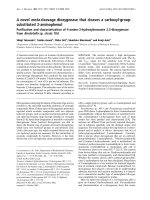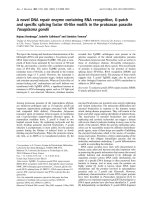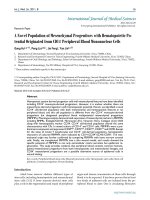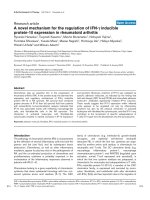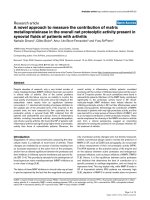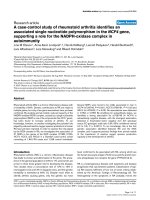Báo cáo y học: "A novel nucleotide insertion in S gene of hepatitis B virus in a chronic carrier" pps
Bạn đang xem bản rút gọn của tài liệu. Xem và tải ngay bản đầy đủ của tài liệu tại đây (478.52 KB, 5 trang )
Tong et al. Virology Journal 2010, 7:104
/>Open Access
RESEARCH
© 2010 Tong et al; licensee BioMed Central Ltd. This is an Open Access article distributed under the terms of the Creative Commons
Attribution License ( which permits unrestricted use, distribution, and reproduction in
any medium, provided the original work is properly cited.
Research
A novel nucleotide insertion in S gene of hepatitis
B virus in a chronic carrier
Wenbin Tong*, Li Sun, Jilan He, Shusen He and Fei Du
Abstract
Hepatitis B virus DNA was extracted from serum of a chronic carrier and polymerase chain reaction was performed on
S gene. Direct sequencing showed a variant HBsAg with additional 4-amino acid insertion, and clone sequencing
confirmed the mixture of variant HBsAg and wildtype HBsAg. Of 16 clones with 12-nucleotide insertion, 15 clones had
identical AGAACAACACAA insertion between nucleotide 494 and nucleotide 495, and one clone had GGAACAACTCAA
insertion in the same position plus 3-nucleotide deletion from nucleotide 491 to nucleotide 493. S114T, C121Y, T126S/
A, Q129K, G130R, T131N, M133T, G145R, N146D substitution and premature stop codon were also found in those
clones. However, the origin of HBV with 4-amino acid insertion in HBsAg was unclear.
Introduction
Hepatitis B virus (HBV) infection is a global health prob-
lem. It was estimated that more than 2 billion of the
global population had been infected. Of these, approxi-
mately 360 million were chronically infected and esti-
mated 500 000-700 000 people died from complications
of infection each year worldwide [1]. HBV infection was
highly endemic in China, a national serosurvey con-
ducted in 2006 showed 7.2% surface antigen(HBsAg)
prevalence in population aged 1~59 years old [2]. Control
and therapy of HBV-related diseases weighed great bur-
den on both government and infected individual [3].
HBsAg, a main serological marker for diagnosis of HBV
infection, comprises 226 amino acids(aa), and contains a
highly conformational epitope cluster in major hydro-
philic region(MHR) extending from aa99-aa169, where
common α determinant is located at aa124-aa147 [4-6].
Antibodies induced by natural infection or by administra-
tion of vaccine direct against α determinant and confer
cross-protective immunity to all subtype [7-9]. However,
aa substitution, insertion or deletion in MHR may cause
the loss of conformational epitope and altered antigenic-
ity of HBsAg, renders HBsAg undetectable, or induces
immune escape variants to evade virus clearance [10-17].
In this study we reported a novel 12-nucleotide(nt) inser-
tion between nt494 and nt495 in S gene, which led 4-aa
insertion between aa113 and aa114 compared with wild-
type HBsAg.
Materials and methods
Sample selection and serological assay
HBV chronic carriers were identified in 2 counties(dis-
tricts) of Sichuan province by serological assay and epide-
miological investigation in a subnational sampling
serosurvey. Partial sequence analysis of S gene was car-
ried out for total 50 sera [18]. The serum 06A26 was
selected in this study because it presented aa insertion in
MHR by partial S gene sequencing.
Blood sample was drawn from a 77-year-old male
patient. Serological assays were positive for HBsAg,
HBeAg and anti-HBc, negative for anti-HBs and anti-
HBe with available commercial ELISA kit(Wantai,
China).
PCR and sequencing
HBV DNA was extracted from serum with QIAamp DNA
Mini Kit(QIAGEN, Germany) according to manufac-
turer's instructions. Primer pair(S006-sense, 5'-CCT-
GCTGGTGGCTCCAGTTC-3', postion 56-75; S007-
antisense, 5'-CCAATTACATATCCCATGAA-3', position
893-874) were used to amplify complete fragment of S
gene with Taq PCR Master Mix Kit(QIAGEN, Germany)
[14]. PCR was performed for 40 cycles, each cycle
included denaturation at 94°C for 30 sec, annealing at
55°C for 1 min, and extension at 68°C for 2 min, with ini-
tial denaturing step at 94°C for 3 min and final amplifica-
* Correspondence:
1
Institute of Microbiological Detection, Sichuan Center for Disease Control and
Prevention, Chengdu 610041, PR China
Full list of author information is available at the end of the article
Tong et al. Virology Journal 2010, 7:104
/>Page 2 of 5
tion step at 68°C for 10 min. PCR amplicon was purified
with Wizard SV Gel and PCR Clean-up System(Promega,
USA) according to manufacturer's instructions. Cycle
sequencing reaction was performed bidirectionally with
same S006 and S007 primers using Bigdye Terminator
v3.1 Cycle Sequencing Kit(Applied Biosystems, USA).
After purification with Sephadex G-50 Fine (Amersham,
Sweden), sequencing products were analyzed on ABI
PRISM 3130 Genetic Analyzer(Applied Biosystems,
Japan).
PCR Amplicon of 06A26 was also cloned into PMD18-
T Vector(TakaRa, China), transformed into E. coli Elec-
tro-Cell DH5α(TakaRa, China) and then sequenced.
S gene sequence of 06A26 PCR amplicon and 20 clones
were deposited in GenBank under accession number
GU145104 and GU358454-GU358473, respectively.
Quantitation of serum HBV DNA
The amount of serum HBV DNA was measured 1.6 × 10
5
copies/mL on the basis of calculation from standard
curve with commercial quantitative realtime PCR
kit(Da'an, China) on 7300 Real Time PCR Sys-
tem(Applied Biosystems, Singapore).
Results
Nucleotide analysis of S gene
Alignment of nt sequences in S gene of 06A26 PCR ampl-
icon and 20 clones with genotype A-H reference isolates
showed a 12-nt insertion between nt494 and nt495 in
PCR amplicon and clone1-clon16. Of 16 clones with 12-
nt insertion, 15 clones showed identical insertion
sequence, AGAACAACACAA. Another clone showed
otherwise insertion sequence, GGAACAACTCAA, and
contained a 3-nt(TCA) deletion from nt491 to nt493(fig-
ure 1). Phylogenetic analysis by Mega3.1 software indi-
cated they belonged to genotype B.
Amino acid sequence analysis of HBsAg
aa sequences were deduced from S gene DNA sequences
of 20 clones. Lys
122
, Lys
160
and Pro
127
indicated they
belonged to subtype adw2.
Compared with consensus sequence of Chinese isolates
retrieved from GenBank with same genotype/subtype,
clone1-clone11 and clone13-clone15 had KNNT inser-
tion, clone12 ENNT insertion and clone16 RNNS inser-
tion between aa113 and aa114, respectively. In addition,
clone16 contained a deletion at aa113. N146D substitu-
tion(A
AC®GAC) occurred in clone5-clon6 at aa146,
leading to loss of N-linked glycosylation site at this posi-
tion. S114T substitution(T
CA®ACA) occurred in all
clones with 4-aa insertion. This 4-aa insertion alone or
plus following aa114 substitution might form a possible
N-linked glycosylation site. Of 4 clones with wildtype
HBsAg, T131N(AC
C®AAC) and M133T(ATG®ACG)
substitution occurred in clon17-clone19, also forming a
possible N-Linked glycosylation site(figure 2).
C121Y(TG
C®TAC), T126S/T126A(ACT®TCT or
A
CT®GCT), Q129K(CAA®AAA), G130R(GGA®
A
GA), G145R(GGA®AGA) and other aa substitution
compared with consensus sequence in MHR were also
showed in figure 2. Premature stop codon occurred in
clone13 at aa156 (TG
G®TAG), aa191 (TGG®TGA) and
aa196(TGG
®TGA), in clone14 at aa206 (TAC®TAG)
and in clone15 at aa223 (TGG
®TGA), respectively.
Discussion
Carman proposed to separate MHR into functional areas
HBs1-HBs5 [19], which relate to antigenic effect of vari-
ants and their selective pressures. Since Yamamoto first
reported 8-aa insertion between aa123 and aa124 in S
gene [14], aa insertion/deletion in HBsAg had been
reported in following studies, they included 2-aa inser-
tion between aa122 and aa123 [15,16], 3-aa insertion
between aa123 and aa124 [16], 1-aa insertion between
aa121 and aa122 [20], 3-aa insertion between aa118 and
aa119 [18], 2-aa deletion from aa110 to aa111 [17], 4-aa
deletion from aa119 to aa122 [17], 3-aa deletion from
aa113 to aa115 [21]. Those insertion/deletion were
located into HBs1-HBs2, so both HBs1 and HBs2 were
hot spots for aa insertion/deletion [5,16,17]. Recently,
Zhou reported 5-aa insertion between aa128 and aa129
[22], which located into HBs3(also in first loop of α deter-
minant). As sequencing data accumulate, more aa inser-
tion/deletion in HBsAg may be found.
HBsAg was detectable in serum of the patient in this
study, despite 4-aa insertion between aa113 and aa114,
compared with HBsAg negative sera described previously
[14,16,17,22]. Of note, HBsAg with 1-aa insertion behind
aa113 in a serum was reported to be detectable only at
low dilution(5 times), while HBsAg without aa insertion
in other sera was detectable at high dilution(at least 16
000 times) [23]. So PCR amplicon was cloned to find co-
existence of wildtype HBsAg that might contribute to
HBsAg detection. Clone sequencing confirmed the mix-
ture of variant HBsAg and wildtype HBsAg. High level of
serum DNA viral load(>1 × 10
5
copies/mL) and 20% of
wildtype HBsAg ensured HBsAg detection [16,24]. Other
experiment such as site-directed mutangenesis is needed
to confirm whether this 4-aa insertion alone or plus fol-
lowing aa114 substitution will alter HBsAg antigenicity
and affect the binding capacity of anti-HBsAg [25,26].
Due to overlapping of S gene with P gene, variation in S
gene may affect catalytic activity of reverse tran-
scriptase(rt) domain in P gene and vice versa [27].
Deduced rt sequences were also analyzed. 12-nt insertion
caused 4-aa insertion(KEQH, REQH, KEQL, respec-
tively) between rt121 and rt122 in clone1-clone16, and
another deletion at rt121 in clone16. Those insertion/
Tong et al. Virology Journal 2010, 7:104
/>Page 3 of 5
deletion were located in junction between conserved
region A and B [28]. No premature stop codon occurred
in corresponding rt domain. Some reported drug-resis-
tant mutants, such as rtF166L and rtP177L [28], were
found in clone18 and clone15, respectively, and rtD205N
mutant(creating premature stop codon at aa196 in over-
lapping HBsAg) in clone13 led to change from YMDD
motif to YMND motif. However, high level of HBV DNA
rival load suggested this 4-aa insertion in rt domain was
less likely to be strong suppression of viral replication
[11,29].
PCR and direct sequencing on PreS1/S2 gene were also
performed, no insertion/deletion was found [14].
The origin of variant HBsAg was unclear. The patient
had no history of vaccination, therapy with interferon-α/
nucleoside analogues, administration of hepatitis B
immune globulin and blood transfusion. Knowing of his
infection status more than thirty years, the patient took
traditional Chinese medicine available for a long time.
Traditional Chinese medicine has been proven economi-
cal and efficient in liver protection and treatment, and
has less side effects compared with interferon α and lami-
vudine [30,31]. However, "Medicine is partly poisonous",
according to traditional Chinese medicine theory, they
may have unknown side effects, due to complex ingredi-
ents usually used in the formulas. Though anti-HBsAg
was negative in the patient serum, it might be existent
under detection limit for applied method. If more sensi-
tive methods were applied, anti-HBsAg could been
detected in nearly all patients with chronic hepatitis B
infection [32,33]. It was possibility that the patient first
infected wildtype HBV, host immunity responded to
HBV infection but failed to clear virus. Selective pressure
from host immunity, traditional Chinese medicine and
other factors in combination favored the replication of
variant HBV with 4-aa insertion in HBsAg and outnum-
bered wildtype HBV.
In summary, we reported a novel 12-nt insertion in S
gene of HBV, which led to 4-aa insertion in HBsAg
between aa113 and aa114, but the origin of the variant
Figure 1 Alignment of nucleotide sequences in the HBs1 region of 06A26 PCR amplicon and clones with genotype A-H reference isolates.
Homologous nucleotides were indicated with dots, deleted nucleotides with dashes. Heterologous nucleotides are specified. Inserted nucleotides
were indicated with grey boxes.
3&5*$&7$7&$$**7$7*77*&&&*777*7&&7&7$$77&&$**$7&$$$*$$&$$&$&$$&$$&*$&&$*&$&&**$
FORQH
FORQH
FORQH
FORQH
FORQH
FORQH
FORQH
FORQH
FORQH
FORQH$$$$
FORQH
FORQH*
FORQH
FORQH
FORQH
FORQH*7
FORQH*7
FORQH*7
FORQH7
FORQH77
$B$)7$*
%B$)7$
&B$%&&$77*
'B;&7&*
(B$%7&7*
)B$%&&&*&*
*B$)*&7*&7*
+B$<*&7&*
Tong et al. Virology Journal 2010, 7:104
/>Page 4 of 5
HBV was unclear. A well-documented immune escape
mutant G145R in one clone, might occur naturally due to
lack of proof-reading activity of rt domain and exist as
quasi-species viral population [34,35].
Competing interests
The authors declare that they have no competing interests.
Authors' contributions
WBT carried out most part of the study and drafted the manuscript. LS, JLH and
SSH took part in serological detection. FD was responsible for epidemiological
data analysis. All authors read and approved the final manuscript.
Acknowledgements
We thank Dr. Yang Wang for sample collection and epidemiological investiga-
tion(Center for Disease Control and Prevention, Qingyang district of Chengdu
city).
Author Details
Institute of Microbiological Detection, Sichuan Center for Disease Control and
Prevention, Chengdu 610041, PR China
References
1. World Health Organization: Hepatitis B vaccines. WER 2004, 79:255-263.
2. Liang XF, Bi SL, Yang WZ, Wang LD, Cui G, et al.: Epidemiological
serosurvey of hepatitis B in China-declining HBV prevalence due to
hepatitis B vaccination. Vaccine 2009, 27:6550-6557.
3. Liu J, Fan DM: Hepatitis B in China. Lancet 2007, 369:1582-1583.
4. Stirk HJ, Thornton JM, Howard CR: A topological model for hepatitis B
surface antigen. Intervirology 1992, 33:148-158.
5. Cooreman MP, Leroux-Roles G, Paulij WP: Vaccine- and hepatitis B
immune globulin-induced escape mutations of hepatitis B virus
surface antigen. J Biomed Sci 2001, 8:237-247.
6. Chiou HL, Lee TH, Kao J, Mau YC, Ho MS: Altered antigenicity of 'α'
determinant variants of hepatitis B virus. J Genl Virol 1997,
78:2639-2645.
7. Alexopoulou A, Dourakis SP: Genetic heterogeneity of hepatitis viruses
and its clinical significance. Current Drug Targets - Inflammation & Allergy
2005, 4:47-55.
8. Waters JA, Kennedy M, Voet P, Hauser P, Carman W, Thomas HC: Loss of
the common "a" determinant of hepatitis B surface antigen by vaccine-
induced escape mutant. J Clin Invest 1992, 90:2543-2547.
9. Kreutz C: Molecular, immunological and clinical properties of mutated
hepatitis B viruses. J Cel Mol Med 2002, 6:113-143.
10. Carman WF, Zanetti AR, Karyiannis P, Waters J, Manzillo G, Tanzi E,
Zuckermann A, Thomas HC: Vaccine-induced escape mutant of
hepatitis B virus. Lancet 1990, 336:325-329.
11. Karthigesu VD, Allison L, Fortuin M, Mendy M, Whittle HC, Howard CR: A
novel hepatitis B virus variant in the sera of immunized children. J Gen
Virol 1994, 75:443-448.
12. Okamoto H, Yano K, Nozaki Y, Matsui A, Miyazaki H, Yamamoto K, Tsuda F,
Machida A, Mishiro S: Mutations within the S gene of hepatitis B virus
transmitted from mothers to babies immunized with hepatitis B
immune globulin and vaccine. Pediatr Res 1992, 32:264-268.
13. Kohno H, Inoue T, Tsuda F, Okamoto H, Akahane Y: Mutations in the
envelope gene of hepatitis B virus variants co-occurring with antibody
to surface antigen in sera from patients with chronic hepatitis B. J Gen
Virol 1996, 77:1825-1831.
14. Yamamoto K, Horikita M, Tsuda F, Itoh K, Akahane Y, Yotsumoto S,
Okamoto H, Miyakawa Y, Mayumi M: Naturally occurring escape
mutants of hepatitis B virus with various mutations in the S Gene in
Received: 31 March 2010 Accepted: 22 May 2010
Published: 22 May 2010
This article is available from: 2010 Tong et al; licensee B ioMed Central Ltd . This is an Open Access article distributed under the terms of the Creative Commons Attribution License ( ), which permits unrestricted use, distribution, and reproduction in any medium, provided the original work is properly cited.Virology Journal 2010, 7:104
Figure 2 Alignment of deduced amino acid sequences in MHR(aa99-aa169) of 20 clones with consensus sequence from published Chinese
isolates with genotype B/subtype adw2(GenBank accession number AB033554, AF100309, D00329, AF397207, EU305547, EU589335 and
GU145102). One-letter code was used for amino acid in consensus sequence, homologous amino acids were indicated with dots, deleted amino acid
with dash, and premature stop codon with asterisk. Heterologous amino acids were specified. Inserted amino acids were indicated with grey boxes.
&RQVHQVXV'<4*0/39&3/,3*667767*3&.7&773$4*760)36&&&7.37'*1&7&,3,366:$)$.</:(:$695
&ORQH.1177$
FORQH.1177$
FORQH.1177$
FORQH.1177$
FORQH.1177$'
FORQH.1177$'
FORQH.1177$
FORQH.1177$)
FORQH.1177$
FORQH7.11771.<5
FORQH.1177$
FORQH(1177$
FORQH.1177$
FORQH.1177$
FORQH.1177$&
FORQH51167$
FORQH5617
FORQH5175
FORQH6.17
FORQH$
Tong et al. Virology Journal 2010, 7:104
/>Page 5 of 5
carriers seropositive for antibody to hepatitis B surface antigen. J Virol
1994, 68:2671-2676.
15. Carman WF, Korula J, Wallace L, MacPhee R, Mimms L, Decker R:
Fulminant reactivation of hepatitis B due to envelope protein mutant
that escaped detection by monoclonal HBsAg ELISA. Lancet 1995,
345:1406-1407.
16. Hou JL, Karayiannis P, Waters J, Luo KX, Liang CS, Thomas HC: A unique
insertion in the S gene of surface antigen-negative hepatitis B virus
Chinese carriers. Hepatology 1995, 21:273-278.
17. Grethe S, Monazahian M, Bohme I, Thomssen R: Characterization of
unusual escape variants of hepatitis B virus isolated from a hepatitis B
surface antigen-negative subject. J Virol 1998, 72:7692-7696.
18. Echevarria J, Avellon A, Magnius L: Molecular epidemiology of hepatitis
B virus in Spain: identification of viral genotypes and prediction of
antigenic subtypes by limited sequencing. J Med Virol 2005, 76:176-184.
19. Carman WF: The clinical significance of surface antigen variants of
hepatitis B virus. J Viral Hepatitis 1997, 4(S1):11-20.
20. Ghany MG, Ayola B, Villamil FG, Gish RG, Tojter S, Vierling JM, Lok A:
Hepatitis B virus S mutants in liver transplant recipients who were
reinfected despite hepatitis B immune globulin prophylaxis.
Hepatology 1998, 27:213-222.
21. Nakano T, Lu L, Hu XL, Mizokami M, Orito E, Shapiro CN, Hadler SC,
Robertson BH: Characterization of hepatitis B virus genotypes among
Yucpa Indians in Venezuela. J Gen Virol 2001, 82:359-365.
22. Zhou YH, Zhou JX, LI L, Bi YC, Liu Y, Pan JS, Wu C: A novel hepatitis B virus
mutant coexisting with wild type virus in a carrier with negative HBsAg
yet positive HBeAg and anti-HBs. J Clin Virol 2009, 46:363-366.
23. Weber B, Bayer A, Kirch P, Schluter V, Schlirper D, Melchior W: Improved
detection of hepatitis B virus surface antigen by a new rapid
automated assay. J Clin Microbiol 1999, 37:2639-2647.
24. Mendy ME, McConkey SJ, Sande M, Crozier S, Kaye S, Jeffries D, Hall AD,
Whittle HC: Changes in viral load and HBsAg and HBeAg status with
age in HBV chronic carriers in The Gambia. Virol J 2008, 5:49.
25. Ashton-Rickardt PA, Murray K: Mutants of the hepatitis b virus surface
antigen that define some antigenically essential residues in the
immunodominant a region. J Med Virol 1989, 29:196-203.
26. Seddigh-Tonekaboni S, Waters JA, Jeffers S, Gehrke R, Ofenloch B, Horsch
A, Hess G, Thomas HC, Karayiannis P: Effect of variation in the common
"a" determinant on the antigenicity of hepatitis B surface antigen. J
Med Virol 2000, 60:113-121.
27. Guestas ML, Mathet VL, Ruiz V, Minassian ML, Rivero C, Sala A, Corach D,
Alessio A, Pozzati M, Frider B, Oubina JR: Unusual naturally occurring
humoral and cellular mutated epitopes of hepatitis B virus in a
chronically infected Argentine patient with anti-HBs antibodies. J Clin
Microbiol 2006, 44:2191-2198.
28. Stuyver LJ, Locarnini SA, Lok A, Richman DD, Carman WF, Dienstag JL,
Schinazi RF: Nomenclature for antiviral-resistant human hepatitis B
virus mutations in the polymerase region. Hepatology 2001, 33:751-757.
29. Alexopoulou A, Baltayiannis G, Jammeh S, Waters J, Dourakis SP,
Karayiannis P: Hepatitis B surface Antigen variant with multiple
mutations in the α determinant in an Agammaglobulinemic patient. J
Clin Microbiol 2004, 42:2861-2865.
30. Wang RB, Kong J, Dali Wang DL, Lien L, Lien E: A survey of Chinese herbal
ingredients with liver protection activities. Chinese Medicine 2007, 2:5.
31. Zhang LY, Wang GQ, Hou WH, Li P, Dulin A, Bonkovsky HL: Contemporary
clinical research of traditional Chinese medicines for chronic hepatitis
B in China: an analytical review. Hepatology 2010, 51:690-698.
32. Ogura Y, Kurosaki M, Asahina Y, Enomoto N, Marumo F, Sato C:
Prevalence and significance of naturally occurring mutations in the
surface and polymerase genes of hepatitis B virus. J Infect Dis 1999,
180:1444-1451.
33. Maruyama T, McLachlan A, Iino S, Koike K, Kurokawa K, Milich DR: The
serology of chronic hepatitis B infection revisited. J Clin Invest 1993,
91:2586-2595.
34. Kidd-Ljunggren K, Miyakawa Y, Kidd AH: Genetic variability in hepatitis B
viruses. J Gen Virol 2002, 83:1267-1280.
35. Osiowy C, Giles E, Tanaka Y, Mizokami M, Minuk GY: Molecular Evolution
of Hepatitis B Virus over 25 Years. J Virol 2006, 80:10307-10314.
doi: 10.1186/1743-422X-7-104
Cite this article as: Tong et al., A novel nucleotide insertion in S gene of hep-
atitis B virus in a chronic carrier Virology Journal 2010, 7:104
